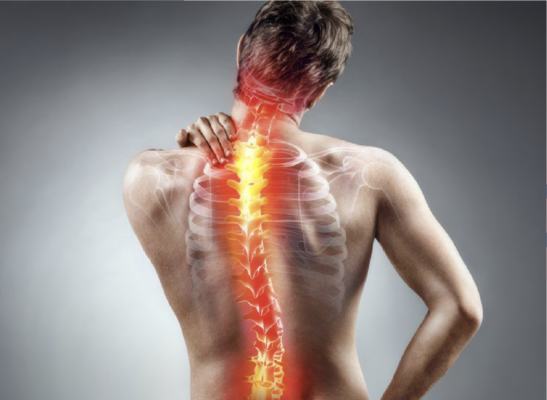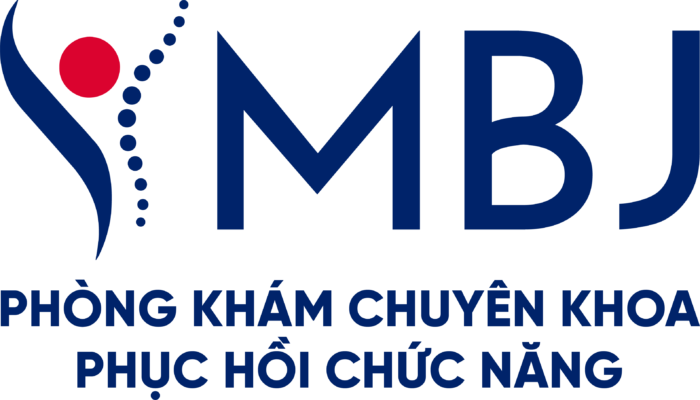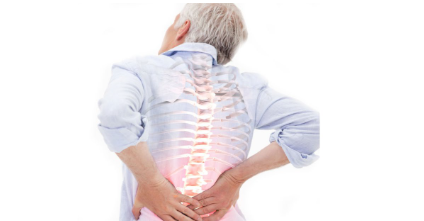Spinal degeneration is one of the most common musculoskeletal diseases and has been trending towards younger demographics in recent years. Not only does it cause pain and affect quality of life, but spinal degeneration, if not treated properly, also poses many serious risks. So, how can spinal degeneration be treated effectively? Let’s find out in the article below.
Nội dung
- 1 What is Spinal Degeneration?
- 2 Main Causes of Spinal Degeneration
- 3 Signs and Symptoms of Spinal Degeneration You Cannot Ignore
- 4 Is Spinal Degeneration Dangerous? What are the Complications?
- 5 Effective Treatment Methods for Spinal Degeneration Today
- 6 Nutrition and Supportive Exercises for Spinal Degeneration at Home
- 7 Why Choose MBJ Functional Rehabilitation Clinic to Treat Spinal Degeneration?
- 8 Frequently Asked Questions (FAQ)
What is Spinal Degeneration?
Spinal degeneration is a chronic pathological condition that occurs when the articular cartilage, intervertebral discs, and subchondral bone in the spine wear down over time. This is a natural aging process of the body but can also progress faster due to an unhealthy lifestyle or underlying medical conditions.
Spinal degeneration typically occurs in two main locations:
- Cervical Spondylosis (Neck Degeneration): Causes pain and stiffness in the neck and shoulders, which can radiate down the arms.
- Lumbar Spondylosis (Lower Back Degeneration): Causes pain in the lower back, which can radiate down to the buttocks and legs.
Main Causes of Spinal Degeneration
Spinal degeneration is a process that occurs silently over time and can be caused by various factors. Specifically:
- Natural Aging: This is the most common cause. As we age, the vertebrae and intervertebral discs gradually lose their elasticity, making them more susceptible to damage and degeneration. This process is a normal part of the body’s aging.
- Mechanical Factors: Improper daily habits or work practices can increase pressure on the spine, leading to premature degeneration. These include:
- Sitting in the wrong posture for long periods or frequently bending over.
- Regularly carrying heavy objects, which puts a significant load on the spine.
- Previous spinal injuries, even if healed, can leave long-term effects.
- Pathological Factors: Certain medical conditions such as arthritis, herniated discs, or congenital spinal deformities can weaken the spinal structure and accelerate the degenerative process.
- Other Factors: Being overweight or obese puts a greater load on the spine than normal. A diet lacking in essential nutrients (like calcium and vitamin D) also weakens bones and joints. Additionally, genetic factors may make some people more prone to degeneration than others.
Signs and Symptoms of Spinal Degeneration You Cannot Ignore
Spinal degeneration often progresses slowly and silently but can lead to severe consequences if not detected and treated in time. Common signs include:
- Persistent Aching Pain: Patients often feel a dull, nagging pain in the affected area of the spine. The pain typically worsens with movement or carrying heavy objects but subsides with rest.
- Pain Location Depends on the Degenerated Area:
- If it’s cervical spondylosis, the patient will feel pain in the neck-shoulder-nape region, which may radiate down the arm, accompanied by numbness in the hand.
- If it’s lumbar spondylosis, the pain appears in the lower back, sometimes radiating to the hips, buttocks, or legs.
- Pain Location Depends on the Degenerated Area:
- Limited Range of Motion: A feeling of joint stiffness in the morning and difficulty bending, arching, or twisting the body are clear signs that the spine is losing its flexibility.
- Grinding or Popping Sounds (Crepitus): Some people may hear “clicking” or “grinding” sounds in their spine when they turn or bend, due to the wearing down of joints and discs.
- Spinal Deformity: In later stages, patients may develop a hunched back (kyphosis) or a curved spine (scoliosis), affecting their posture and appearance.
- Nerve Compression: When degenerated structures press on nerves, patients may experience numbness or tingling in their limbs, muscle weakness, or even loss of sensation in certain parts of the body.
- In particular, many cases of cervical spondylosis lead to hand numbness, reducing the ability to work and perform daily activities like holding objects, writing, or even getting dressed.
Is Spinal Degeneration Dangerous? What are the Complications?
If not treated promptly, spinal degeneration can lead to many dangerous complications, and over time, may result in muscle atrophy and paralysis.
Complications of spinal degeneration can include: Bone Spurs (Osteophytes), Herniated Discs, Spinal Stenosis, Muscle Atrophy and Limb Weakness, Vestibular Disorders, Cerebral Ischemia (due to cervical spondylosis), and Severe Impairment of Motor Function.
Effective Treatment Methods for Spinal Degeneration Today
Non-Surgical Treatment
Daily Lifestyle Changes:
- Correct Your Posture: Maintain proper posture when sitting, standing, and lying down – avoid slouching, bending your head for too long, or sleeping in a position that puts pressure on the spine.
- Weight Management: Maintaining a healthy weight helps reduce the load on the spine, especially in the lumbar region.
- Proper Nutrition: Supplement with essential nutrients for bones and joints such as calcium, vitamin D, glucosamine, and omega-3s through food and/or supportive supplements.
Physical Therapy and Functional Rehabilitation: This is a crucial supportive method to help reduce pain, increase spinal flexibility, and restore motor function:
- Therapeutic Ultrasound: Has pain-relieving, anti-inflammatory effects and softens stiff muscles.
- High-Intensity Laser: Helps stimulate the body’s natural healing of damaged tissues and supports new tissue regeneration.
- Spinal Traction: Reduces the pressure on discs and nerve roots – the cause of pain and numbness.
- Chiropractic Adjustment: A method using hands to realign displaced joints in the spine, helping to release compressed areas.
- Therapeutic Exercise: Gentle exercises designed specifically to maintain the flexibility and strength of the muscles around the spine.
Medical Treatment for Spinal Degeneration
When pain symptoms affect daily life, doctors often prescribe medical treatment (medication) to control the condition. Some common groups of drugs include:
- Pain Relievers: Drugs like Paracetamol or nonsteroidal anti-inflammatory drugs (NSAIDs) are often used to relieve mild to moderate pain. NSAIDs also have an anti-inflammatory effect.
- Anti-inflammatory Drugs: In addition to NSAIDs, some cases may require stronger anti-inflammatory drugs if the spinal inflammation is prolonged or widespread.
- Muscle Relaxants: Help to soften muscles and reduce muscle stiffness around the degenerated area, thereby improving mobility and reducing pain. Important Note: The use of any medication must follow the guidance of a specialist. Self-medication can cause side effects such as stomach pain, liver or kidney damage, or drug dependence.
Surgical Treatment for Spinal Degeneration
Surgery is not the first treatment option but is only considered in particularly severe cases. Specifically:
When is surgery necessary?
- When conservative treatment methods such as medication, physical therapy, and lifestyle changes do not yield results after a period of treatment.
- When the patient experiences severe complications such as: Spinal stenosis (the spinal canal is compressed, causing pain and motor dysfunction), or a large herniated disc that compresses nerves, causing loss of sensation or weakness in the limbs.
Some common surgical methods:
- Bone Spur Removal (Osteophytectomy): Removes the excess bone growth that is compressing soft tissues or nerves.
- Artificial Disc Replacement: Applied when the disc is severely damaged and cannot recover.
- Spinal Fusion: Fuses vertebrae together to stabilize the spine, reduce pain, and prevent further damage. Important Note: Surgery is a last resort due to high costs, a long recovery process, and potential risks such as infection, nerve damage, or recurrence after surgery.
Nutrition and Supportive Exercises for Spinal Degeneration at Home
In addition to medication or specialized treatment, maintaining a healthy lifestyle at home plays a crucial role in managing and slowing the progression of spinal degeneration. Specifically:
You should supplement with foods rich in nutrients for bones and joints, including:
- Fatty fish (like salmon, mackerel): Rich in omega-3s, which help fight inflammation.
- Eggs, milk: Provide calcium and vitamin D for a strong skeletal system.
- Dark green vegetables, almonds, soybeans: Rich in antioxidants and micronutrients beneficial for joint cartilage.
Limit foods that cause inflammation and affect bones and joints, such as:
- Fried foods, fast food, and greasy items.
- Alcohol and tobacco – factors that weaken bone structure and affect blood circulation that nourishes the spine.
Gentle supportive exercises at home: Proper exercise can improve flexibility, reduce pain, and maintain motor function. Some simple exercises you can do:
- Gentle flexion and extension of the neck or lower back: Helps relax the spine and reduce stiffness.
- Basic Plank: Strengthens the core muscles (abdominal and back), which help support the spine.
- Stretching Yoga: Gentle poses help stretch the spine and improve blood circulation, but it is advisable to consult an expert before practicing to avoid incorrect postures that could cause injury.
Why Choose MBJ Functional Rehabilitation Clinic to Treat Spinal Degeneration?
For patients with spinal degeneration, choosing the right treatment center is crucial for improving outcomes and avoiding unnecessary interventions like surgery. MBJ is a trusted address chosen by many due to its outstanding advantages:
- Application of Modern Technology: The clinic uses advanced equipment such as high-intensity lasers and the DTS traction system to provide fast pain relief, restore damaged tissues, and safely release nerve compression without being invasive.
- Fully Certified and Experienced Medical Team: 100% of our doctors are graduates in Musculoskeletal specialties with over 15 years of domestic treatment experience and regular professional training abroad.
- Highly Skilled Team of Therapists: MBJ brings together a team of musculoskeletal therapists with a solid professional foundation, who are formally trained to directly monitor and adjust the treatment process for each patient.
- Personalized Treatment Protocols: Instead of a one-size-fits-all approach, at MBJ, each patient receives a customized plan tailored to their health condition, level of degeneration, and the body’s response.
- Affordable Costs – No Surgery Required: With the goal of minimizing invasiveness, MBJ offers an optimal conservative treatment solution that helps patients reduce pain and improve mobility without resorting to surgery, saving costs and shortening recovery time.

Frequently Asked Questions (FAQ)
1. How long does it take to treat spinal degeneration? Depending on the specific condition of each patient, the doctor will provide a suitable treatment plan, which can range from a few weeks to several months.
2. Is the treatment cost high? If treated early, focusing mainly on physical therapy and rehabilitation exercises, the cost is moderate. Surgery will be more expensive.
3. Should I walk or run if I have spinal degeneration? Gentle walking is acceptable. You should limit running if you have significant pain or are undergoing acute treatment.
4. Can spinal degeneration be completely cured? It cannot be completely cured, but the symptoms can be well-managed, and complications can be prevented from returning.
Treating spinal degeneration requires patience and cooperation between the doctor, physical therapist, and the patient. Early detection and proper treatment will help patients live a healthy, active life and avoid dangerous complications in the future. If you are experiencing any suspicious signs, do not hesitate – see a specialist as soon as possible.

 Tiếng Việt
Tiếng Việt

